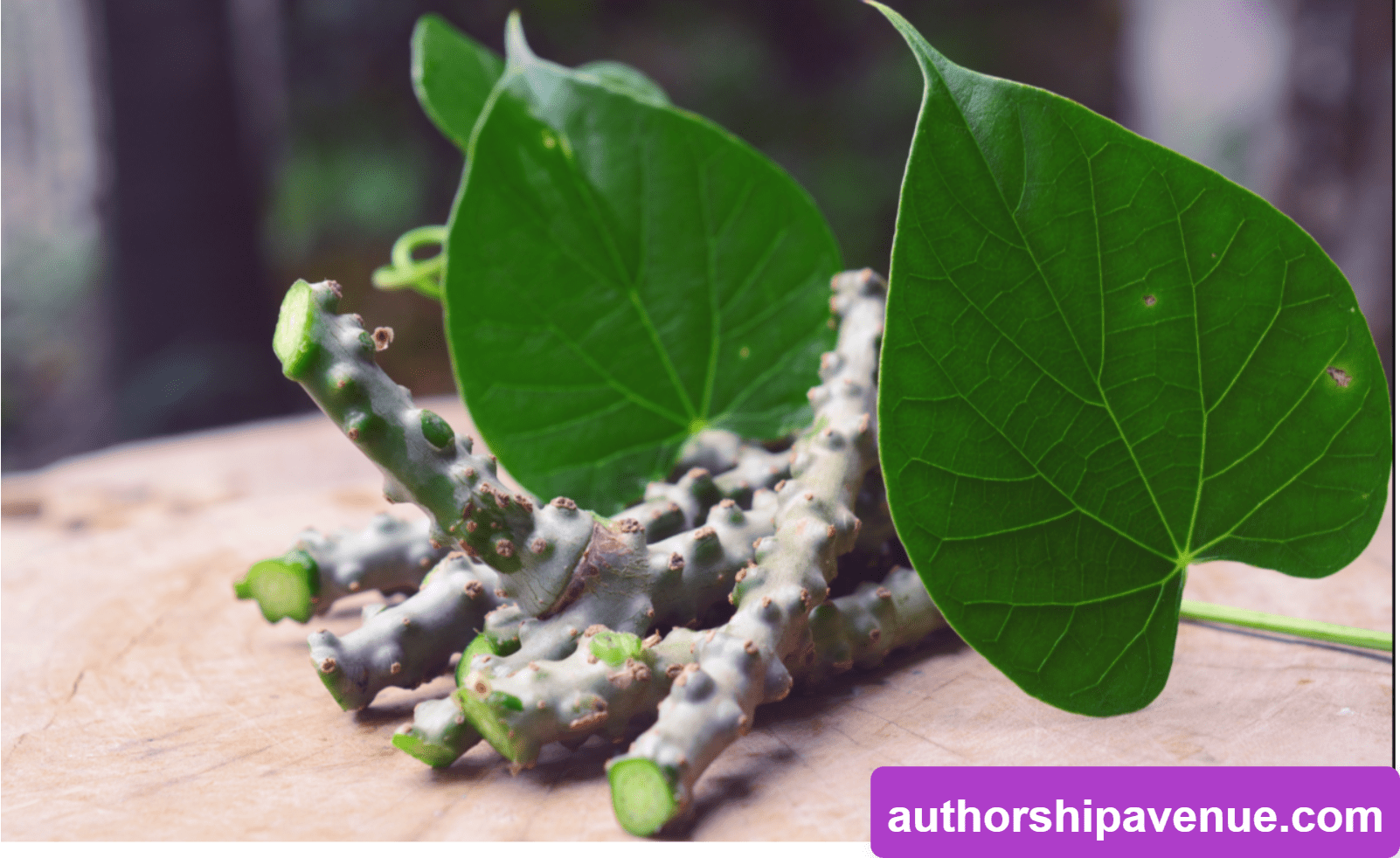Giloy (Tinospora cordifolia) is a common climbing shrub that grows on other trees. In Ayurvedic medicine, giloy is known as the queen of herbs and has been used for centuries to treat various ailments, including chronic fever, flu, cold, hair loss, and arthritis. The stem of giloy is particularly valued for its numerous properties, such as antioxidant, antidiabetic, antispasmodic, antiarthritic, antiallergic, antistress, anti-inflammatory, immunomodulatory, and antineoplastic.
What is Giloy?
Giloy belongs to the Menispermaceae family. This herbaceous vine is native to tropical regions of the Indian subcontinent and is also found in China and tropical areas of Australia and Africa. The roots, stems, and leaves are used in Ayurvedic medicine to treat fever, infections, and diabetes. Giloi is also known by various names, including Ambervel, Amrita, Guduchi, and Heart-leaved moonseed. The Sanskrit word “Amrita,” from which giloy is derived, means “the root of immortality.”
What is Giloy Used For?
It is used to treat various conditions, such as gout, rheumatoid arthritis, constipation, liver diseases, skin problems, chronic fever, diabetes, asthma, hay fever, and high cholesterol. Additionally, giloy acts as an immunity booster and aids in digestion.
Nutritional Value of Giloy
Studies have shown that different parts of the this plant, including the roots and stems, are rich in antioxidants and phytochemicals. The four major compounds found in giloi are:
- Terpenoids: Contribute to the fragrance, taste, and color of the plant.
- Alkaloids: Including berberine and choline, these are powerful compounds that give some plants their bitter taste.
- Lignans: Including polysaccharides, these prevent the growth of viruses, fungi, and other microbes.
- Steroids: Including beta-sitosterol, which have a similar chemical structure to cholesterol.
Other active compounds and nutrients in giloi include diterpenoid lactones, sesquiterpenoid and phenolics, aliphatic compounds, glycosides, lycopene, carotenes, and anthocyanin.
Potential Giloy Benefits
- Boosts Immunity: Contains antioxidant properties that protect cells from oxidative damage, rejuvenate the body, and improve health by flushing out free radicals and removing toxins from the liver and kidneys.
- Treats Chronic Fever: Natural anti-inflammatory and antipyretic properties that increase blood platelet count and alleviate symptoms of dengue fever and malaria.
- Improves Digestion: Regular consumption of giloy powder with Indian gooseberry can prevent digestive problems like diarrhea, colitis, nausea, and hyperacidity. juice of this plant leaves with buttermilk is effective for people suffering from piles.
- Regulates Blood Sugar Levels: Acts as a hypoglycemic agent, making cells less insulin-resistant. Contains berberine, which helps regulate blood sugar, reduce bad cholesterol, and lower blood pressure.
- Prevents and Treats Several Diseases: Can be used to treat asthma, arthritis, eye disorders, mental stress, and anxiety.
- Manages Arthritis and Gout: Anti-inflammatory and antiarthritic properties help relieve joint pain and inflammation.
- Enhances Skin Health: Antioxidants in giloi improve skin cell health, regenerate skin cells, and possess anti-aging properties that reduce fine lines, wrinkles, and droopy skin.
Downsides of Using Giloy
While consuming it in recommended doses is generally safe for healthy individuals, it can cause side effects such as constipation, stomach irritation, hypoglycemia (low blood sugar levels), fatigue, and dizziness. People with autoimmune diseases like rheumatoid arthritis, lupus, or Crohn’s disease should avoid giloy as it may overstimulate the immune system. Pregnant or lactating women should also avoid giloy due to a lack of data on its safety for these populations.
Recommended Dosage of Giloy
- Giloi stem powder: 2 to 6 grams per day in divided doses.
- Giloy juice: 2 to 3 teaspoons mixed with water, ideally consumed on an empty stomach in the morning.
- Children: No more than 500 mg twice a day.
Always follow the specific product’s dosage recommendations and directions carefully.
How to Use Giloy
It is available in various forms, including pills, capsules, dried powder, and tinctures (juice made from the roots and stems). For topical use, it can be found in creams or lotions.
For Rejuvenating Skin:
- Boil 6 to 7 giloi leaves in water.
- Let it cool and strain the water.
- Apply it evenly to the face, leave it on for about 15 to 20 minutes, and rinse with lukewarm water.
For Hair:
- Mix 3 to 6 grams of giloi powder with one glass of water to make a paste.
- Apply the paste on the scalp, hair, and tips.
- Leave it on for about 30 minutes and then rinse with shampoo.
